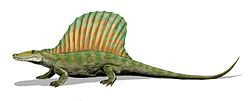| Palaeohatteriidae Temporal range: Early Permian, | |
|---|---|
 | |
| Palaeohatteria longicaudata | |
| Scientific classification | |
| Domain: | Eukaryota |
| Kingdom: | Animalia |
| Phylum: | Chordata |
| Clade: | Synapsida |
| Clade: | Sphenacomorpha |
| Clade: | Sphenacodontia |
| Clade: | Pantherapsida |
| Family: | † Palaeohatteriidae Baur, 1889 |
| Type species | |
| † Palaeohatteria longicaudata | |
| Genera | |
| |
Palaeohatteriidae [1] is an extinct family of basal sphenacodonts known from the Early Permian period (Asselian-Sakmarian stages) of Saxony, Germany. [2] Two genera are known: Palaeohatteria [3] and Pantelosaurus . [4]





